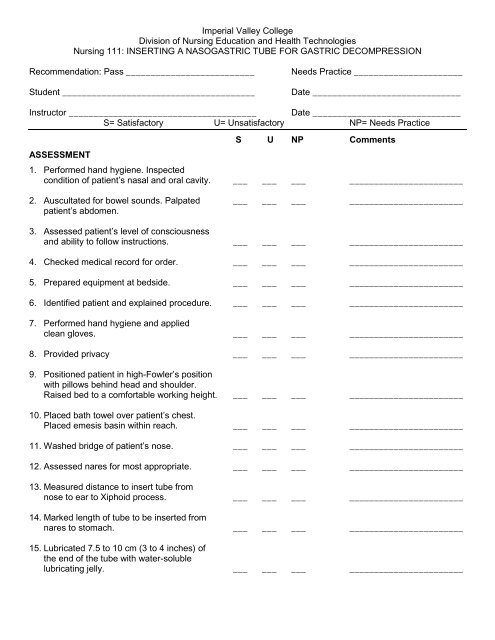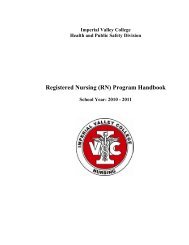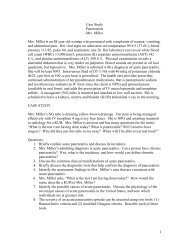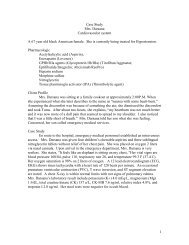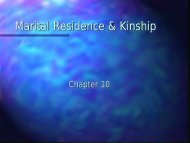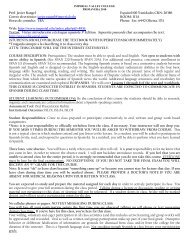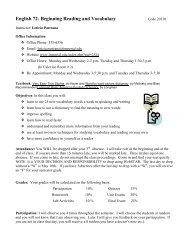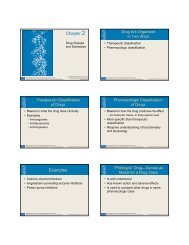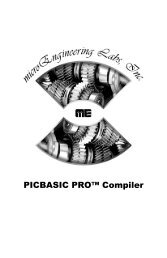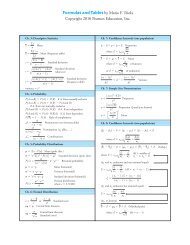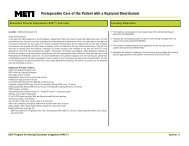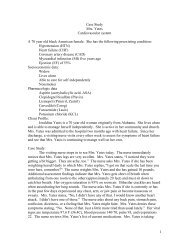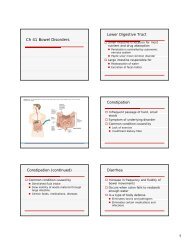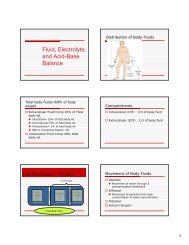NURS 111 Check list Inserting a nasogastric tube for gastric ...
NURS 111 Check list Inserting a nasogastric tube for gastric ...
NURS 111 Check list Inserting a nasogastric tube for gastric ...
You also want an ePaper? Increase the reach of your titles
YUMPU automatically turns print PDFs into web optimized ePapers that Google loves.
Imperial Valley CollegeDivision of Nursing Education and Health TechnologiesNursing <strong>111</strong>: INSERTING A NASOGASTRIC TUBE FOR GASTRIC DECOMPRESSIONRecommendation: Pass __________________________Student _______________________________________Needs Practice ______________________Date ______________________________Instructor ______________________________________ Date ______________________________S= Satisfactory U= Unsatisfactory NP= Needs PracticeASSESSMENTS U NP Comments1. Per<strong>for</strong>med hand hygiene. Inspectedcondition of patient’s nasal and oral cavity. ___ ___ ___ _______________________2. Auscultated <strong>for</strong> bowel sounds. Palpated ___ ___ ___ _______________________patient’s abdomen.3. Assessed patient’s level of consciousnessand ability to follow instructions. ___ ___ ___ _______________________4. <strong>Check</strong>ed medical record <strong>for</strong> order. ___ ___ ___ _______________________5. Prepared equipment at bedside. ___ ___ ___ _______________________6. Identified patient and explained procedure. ___ ___ ___ _______________________7. Per<strong>for</strong>med hand hygiene and appliedclean gloves. ___ ___ ___ _______________________8. Provided privacy ___ ___ ___ _______________________9. Positioned patient in high-Fowler’s positionwith pillows behind head and shoulder.Raised bed to a com<strong>for</strong>table working height. ___ ___ ___ _______________________10. Placed bath towel over patient’s chest.Placed emesis basin within reach. ___ ___ ___ _______________________11. Washed bridge of patient’s nose. ___ ___ ___ _______________________12. Assessed nares <strong>for</strong> most appropriate. ___ ___ ___ _______________________13. Measured distance to insert <strong>tube</strong> fromnose to ear to Xiphoid process. ___ ___ ___ _______________________14. Marked length of <strong>tube</strong> to be inserted fromnares to stomach. ___ ___ ___ _______________________15. Lubricated 7.5 to 10 cm (3 to 4 inches) ofthe end of the <strong>tube</strong> with water-solublelubricating jelly. ___ ___ ___ _______________________
S U NP Comments16. Alerted patient that procedure was aboutto begin. ___ ___ ___ _______________________17. Instructed patient to extend neck, andinserted <strong>tube</strong> slowly through naris withcurved end pointing downward. ___ ___ ___ _______________________18. Continued to pass <strong>tube</strong> along floor ofnasal passage. ___ ___ ___ _______________________19. If resistance met, rotated <strong>tube</strong> orwithdrew <strong>tube</strong>, allowed patient to rest,relubricated <strong>tube</strong>, and inserted intoother naris. ___ ___ ___ _______________________20. With <strong>tube</strong> above oropharynx, instructedpatient to flex head <strong>for</strong>ward and take asip of water if allowed or dry swallow;advanced the <strong>tube</strong> 1 to 2 inches with eachswallow. ___ ___ ___ _______________________21. If patient began to cough, gag, or choke,stopped <strong>tube</strong> advancement; instructedpatient to breathe easily. ___ ___ ___ _______________________22. If patient continued to cough, pulled <strong>tube</strong>back slightly. ___ ___ ___ _______________________23. If patient continued to gag, checked backof oropharynx. ___ ___ ___ _______________________24. After patient relaxed, continued to advance<strong>tube</strong> the desired distance. After <strong>tube</strong> hadbeen advanced, anchored <strong>tube</strong> with preparedsplit tape marked <strong>tube</strong> length. ___ ___ ___ _______________________25. Verified <strong>tube</strong> placement, according to agencypolicy.a. Ask patient to talk. ___ ___ ___ _______________________b. Aspirated gently back on syringe toobtain <strong>gastric</strong> content. ___ ___ ___ _______________________c. Measured pH of aspirate ___ ___ ___ _______________________d. Had x-ray examination of chest andabdomen per<strong>for</strong>med, if ordered. ___ ___ ___ _______________________e. Injected 30cc air into <strong>tube</strong> whileauscultating over epigasture area. ___ ___ ___ _______________________f. If <strong>tube</strong> not in stomach, advanced it 1 to 2inches and repeated steps to check <strong>tube</strong>position. ___ ___ ___ _______________________
S U NP Comments26. Anchoring Tubea. Clamped end or connected to a drainagebag or suction machine. ___ ___ ___ _______________________b. Taped <strong>tube</strong> to nose or applied commercial<strong>tube</strong> fixation device; avoided puttingpressure on nares. ___ ___ ___ _______________________c. Fastened end of NG <strong>tube</strong> to patient’sgown with rubber band and safety pin;provided slack <strong>for</strong> patient’s movement.Maintained pigtail of Salem sump <strong>tube</strong>above level of stomach. ___ ___ ___ _______________________d. Kept head of bed elevated 30 degrees,unless contraindicated. ___ ___ ___ _______________________e. Removed gloves and per<strong>for</strong>med handhygiene. ___ ___ ___ _______________________27. After <strong>tube</strong> placement confirmed,a. Placed mark on tape where <strong>tube</strong> exist nose. ___ ___ ___ _______________________b. Option: Measured <strong>tube</strong> length from naresto connector. ___ ___ ___ _______________________RECORDING AND REPORTING1. Correctly recorded insertion procedure,patient’s tolerance, character of drainage, ___ ___ ___ _______________________and <strong>tube</strong> length ___ ___ ___ _______________________


